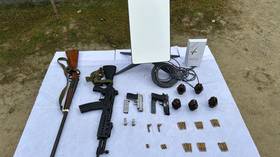Central banks’ gold-buying spree to continue in coming years as global economic doubts rise

Heightened global tensions, currency wars, and the course of de-dollarization have been pushing central banks to boost their gold purchases. The trend is likely to continue in the coming years, experts say.
Data from the World Gold Council shows that in the first half of this year, the banks bought a record 374 metric tons of gold worth $15.7 billion.
As concerns over trade disputes and global growth boost investors’ appetite for safe-haven assets, gold remains one of the prime secure destinations, says Lukman Otunuga, senior research analyst at FXTM (a global foreign exchange trading platform).
Also on rt.com Going for gold: Russia boosts bullion stockpile by 9 tons in July“As long as the appetite for risk is dented by global growth fears, trade tensions and uncertainties over Brexit, among many other geopolitical risk factors, gold will remain in the driving seat,” Otunuga told China Daily.
This booming trend is likely to continue in the coming years, according to Australia and New Zealand Banking Group (ANZ). It projected that central banks’ acquisitions of the yellow metal are likely to remain above 650 tons per year.
“In the current environment, where uncertainty in emerging-market currencies is high, we see a good reason for countries like Russia, Turkey, Kazakhstan and China to continue to diversify their portfolios,” ANZ strategists said as cited by Kitco.
According to the International Monetary Fund, in terms of foreign exchange reserves, China ranked at the top globally at the end of 2018, with a total of $3.07 trillion. China has been indicated by ANZ as the country with the most potential to step up gold purchases in the coming years.
“The People’s Bank of China holds nearly 1,936 tons of gold, which equates to only three percent of its total foreign reserve holdings, giving the country plenty of room to increase its allocation,” said ANZ.
It also noted the impressive growth of Russian gold holdings where the country’s central bank has added more than 96 tons of the precious metal since the beginning of 2019.
“Russia’s central bank has been the largest and most consistent buyer of gold in recent years, almost doubling its reserve (from 1,040t to 2,219t) in the last five years. Much of this has been to the detriment of its US debts and currency, and is in response to increased political risks and sanctions by Western countries,” ANZ said.
It added that increased central bank gold purchases have been one of the key factors supporting higher gold prices. The price of the metal has been on the rise, surging above $1,500 an ounce in August and hitting fresh 6.5-year highs. It was trading at $1,525.87 per ounce on Friday.
For more stories on economy & finance visit RT's business section















